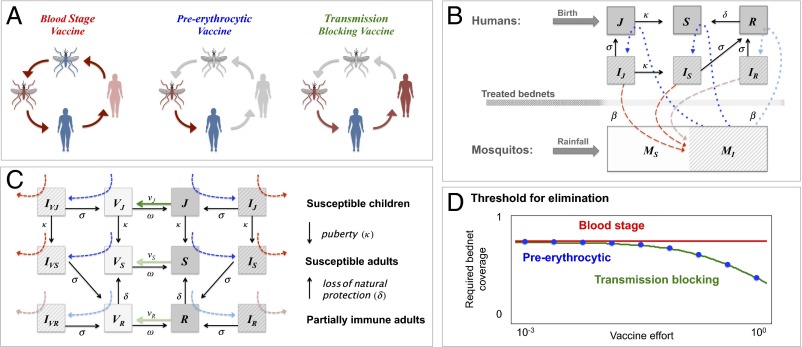Fig. 1.
(A) Vaccines interfering with the Pf life cycle: BSV protects from clinical disease but does not break the life cycle of the parasite because it does not block infection. PEV blocks infection, implying that hosts are both protected from disease and that the life cycle of Pf is broken. TBV does not provide any protection from disease, but it reduces the likeliness of secondary infections, hence breaking the life cycle of Pf (SI Appendix, section IV). (B) A sketch of the basic compartmental model with coupled hosts and vector dynamics (SI Appendix, sections I and II): mosquitoes are either susceptible to infection (MS) or infected (MI), whereas the human population is structured by (i) age: young children under the age of 5 (J + IJ) vs. older children and adults (S + IS + R + IR); (ii) infection status: infected hosts (IJ + IS + IR) vs. noninfected hosts (J + S + R); and (iii) disease risk: hosts susceptible to clinical disease (IJ + IS) vs. hosts with partial protective immunity susceptible only to mild or asymptomatic infections (IR) (Methods). By differentiating these classes, we can express the general occurrence of morbidity relative to asymptomatic infection and distinguish between morbidity in adults vs. young children (47). Transmission of infection takes place from infected mosquitoes to susceptible humans (τMH, in blue), and from infected humans to susceptible mosquitoes (τHM, in red). Treated bednets can reduce the biting rate β by providing physical and chemical barriers between mosquitos and humans. Duration of infection is 1/σ (d), 1/δ is the duration of natural immunity (y), and 1/κ = 5 y, the time children spend in the juvenile age group. (C) A vaccinated state is defined for each host class (VJ, VS, and VR). We consider young children are vaccinated at a higher rate than the rest of the population (νJ >> νS and νR) and the possibility that naturally immune hosts may be less susceptible to infection (τMH,J, τMH,S ≥ τMH,R ) and/or less infectious to mosquitoes when infected (τHM,IJ, τMH,I,S ≥ τMH,I,R; shades of green, blue, and red, respectively). Vaccine protection lasts 1/ω (y), but depending on vaccine type hosts may still be susceptible to infection (IVJ, IVS, and VIVR). A generalized version of the model with multiple age groups is provided in SI Appendix, section II. (D) The level of bednet coverage needed to cross the elimination threshold (R0 ≤ 1; Eq. 1) as a function vaccine effort log (νJ). Parameters: NH = 5,000, NM = 5,000, β = 0.5, ε = 0.2, ξ = 0.4, 1/σ = 60 d, 1/δ = 1/δV = 2, 1/κ = 5 y, 1/αJ = 1/αS = 1/μH = 30 y, 1/μM = 20 d, λrainfall = NM × μM, and νJ = νS/100 = νR/100(y−1). For all classes, i = J,S,R: τMH,I = τHM,i = 0.5, for BSV, τMH,V = τHM,V = 0.5, for PEV, τMH,V = 0, and for TBV, τMH,V = 0.5 and τHM,V = 0.

